大学英语语法课程简介
- 格式:ppt
- 大小:1.25 MB
- 文档页数:36
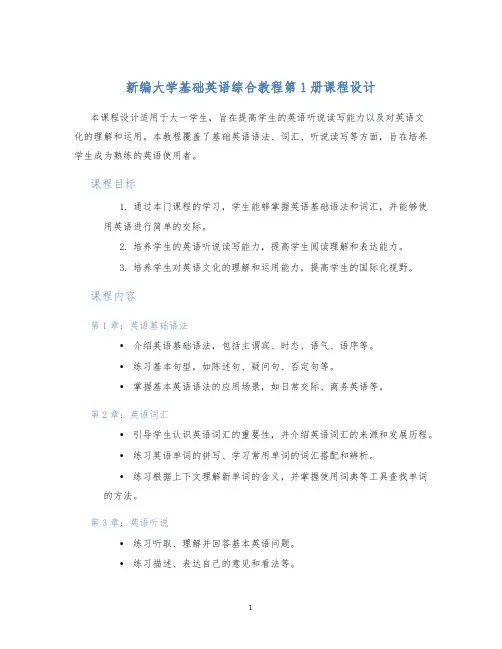
新编大学基础英语综合教程第1册课程设计本课程设计适用于大一学生,旨在提高学生的英语听说读写能力以及对英语文化的理解和运用。
本教程覆盖了基础英语语法、词汇、听说读写等方面,旨在培养学生成为熟练的英语使用者。
课程目标1.通过本门课程的学习,学生能够掌握英语基础语法和词汇,并能够使用英语进行简单的交际。
2.培养学生的英语听说读写能力,提高学生阅读理解和表达能力。
3.培养学生对英语文化的理解和运用能力,提高学生的国际化视野。
课程内容第1章:英语基础语法•介绍英语基础语法,包括主谓宾、时态、语气、语序等。
•练习基本句型,如陈述句、疑问句、否定句等。
•掌握基本英语语法的应用场景,如日常交际、商务英语等。
第2章:英语词汇•引导学生认识英语词汇的重要性,并介绍英语词汇的来源和发展历程。
•练习英语单词的拼写、学习常用单词的词汇搭配和辨析。
•练习根据上下文理解新单词的含义,并掌握使用词典等工具查找单词的方法。
第3章:英语听说•练习听取、理解并回答基本英语问题。
•练习描述、表达自己的意见和看法等。
•练习不同语音语调的模仿,提高听说的流利度。
第4章:英语阅读•练习阅读英语短文、新闻等,理解文章的主题、大意和细节。
•掌握阅读技巧,如寻找关键词、预测文章内容、注意上下文等。
•练习根据文章内容回答问题,培养学生的阅读理解能力。
第5章:英语写作•练习英语写作技巧,包括句型、段落结构和语法等。
•练习表达自己的思想和观点,如写作日记、个人陈述等。
•练习写作常见类型文章,如求职信、邀请信等。
教学方法本课程采用多种教学方法,包括听讲、阅读、写作、讨论、演讲等。
教师将会提供丰富的教学材料,如教科书、音频、视频、练习册,通过交互式教学,培养学生的英语听说读写能力。
评估方式学生的学习成果将通过考试、练习、作业等方式进行评估。
具体评估方式包括:1.阅读理解测试:检测学生阅读理解能力,学生需要根据文章回答相关问题。
2.语音语调测试:测试学生的语音语调模仿能力,学生需要模仿不同语音语调。
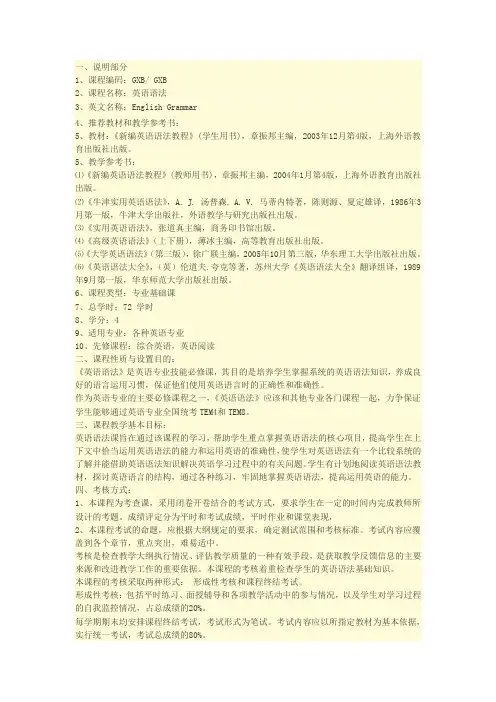
1、课程编码:GXB/ GXB2、课程名称:英语语法3、英文名称:English Grammar4、推荐教材和教学参考书:5、教材:《新编英语语法教程》(学生用书),章振邦主编,2003年12月第4版,上海外语教育出版社出版。
5、教学参考书:⑴《新编英语语法教程》(教师用书),章振邦主编,2004年1月第4版,上海外语教育出版社出版。
⑵《牛津实用英语语法》,A. J. 汤普森, A. V. 马蒂内特著,陈则源、夏定雄译,1986年3月第一版,牛津大学出版社,外语教学与研究出版社出版。
⑶《实用英语语法》,张道真主编,商务印书馆出版。
⑷《高级英语语法》(上下册),薄冰主编,高等教育出版社出版。
⑸《大学英语语法》(第三版),徐广联主编,2005年10月第三版,华东理工大学出版社出版。
⑹《英语语法大全》,(英)伦道夫.夸克等著,苏州大学《英语语法大全》翻译组译,1989年9月第一版,华东师范大学出版社出版。
6、课程类型:专业基础课7、总学时:72 学时8、学分:49、适用专业:各种英语专业10、先修课程:综合英语,英语阅读二、课程性质与设置目的:《英语语法》是英语专业技能必修课,其目的是培养学生掌握系统的英语语法知识,养成良好的语言运用习惯,保证他们使用英语语言时的正确性和准确性。
作为英语专业的主要必修课程之一,《英语语法》应该和其他专业各门课程一起,力争保证学生能够通过英语专业全国统考TEM4和TEM8。
三、课程教学基本目标:英语语法课旨在通过该课程的学习,帮助学生重点掌握英语语法的核心项目,提高学生在上下文中恰当运用英语语法的能力和运用英语的准确性,使学生对英语语法有一个比较系统的了解并能借助英语语法知识解决英语学习过程中的有关问题。
学生有计划地阅读英语语法教材,探讨英语语言的结构,通过各种练习,牢固地掌握英语语法,提高运用英语的能力。
四、考核方式:1、本课程为考查课,采用闭卷开卷结合的考试方式,要求学生在一定的时间内完成教师所设计的考题。

英语十大词类语法课教案教案标题:掌握英语十大词类语法教案目标:1. 学生能够识别和理解英语中的十大词类,并能正确运用它们进行句子构建。
2. 学生能够分辨不同词类在句子中的作用和功能。
3. 学生能够通过练习和应用,巩固并增强对英语十大词类的掌握能力。
教学资源:1. 教材:英语语法教材、课本和练习题。
2. 多媒体:电子白板、投影仪等。
3. 辅助教学工具:单词卡片、练习题、游戏等。
教学过程:1. 导入(5分钟):- 通过多媒体展示英语中的十大词类,包括名词、代词、动词、形容词、副词、介词、连词、冠词、感叹词和数词。
- 引导学生讨论并提出对这些词类的初步认识和了解。
2. 知识讲解(15分钟):- 依次介绍十大词类的定义、特征和在句子中的作用。
- 通过实例帮助学生更好地理解和记忆不同词类的用法和意义。
3. 识别与分类(15分钟):- 准备一系列词语或句子,让学生根据课前学习的知识,将其归类为不同的词类。
- 学生可通过个人或小组讨论的方式完成词类的分类,并对比检查答案。
4. 句子构建(20分钟):- 分发给学生一些基础句子,要求学生根据词类知识,进行适当的补全或调整,使句子语法正确并具有逻辑连贯性。
- 学生可以分组讨论并共同完成句子构建练习,教师进行现场指导和纠正。
5. 练习与巩固(15分钟):- 提供一系列不同难度的练习题,要求学生根据题目要求,选择正确的词类来填空。
- 鼓励学生积极参与,提高对英语十大词类的识别和应用能力。
6. 总结与拓展(10分钟):- 回顾教学过程中的重点和难点内容,对学生的表现进行评价和鼓励。
- 提供一些额外的拓展活动或课后作业,让学生进一步巩固和拓展对英语十大词类的理解和应用。
评估方法:1. 记录学生参与课堂讨论的积极程度和准确性。
2. 观察学生在句子构建和填空练习中的表现。
3. 检查学生完成的练习题和课后作业。
教案扩展:1. 可以设计相关的游戏或活动,提高学生对词类的识别能力,如拼词比赛、填词接龙等。
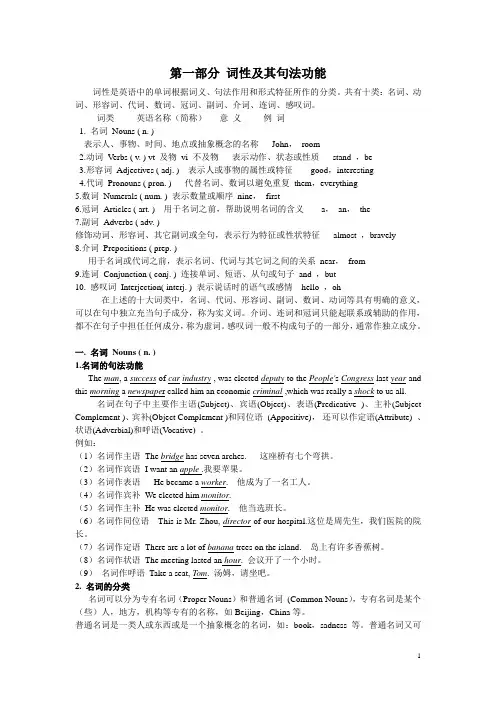
第一部分词性及其句法功能词性是英语中的单词根据词义、句法作用和形式特征所作的分类。
共有十类:名词、动词、形容词、代词、数词、冠词、副词、介词、连词、感叹词。
词类英语名称(简称)意义例词1. 名词Nouns ( n. )表示人、事物、时间、地点或抽象概念的名称John,room2.动词Verbs ( v. ) vt 及物vi 不及物表示动作、状态或性质stand ,be3.形容词Adjectives ( adj. ) 表示人或事物的属性或特征good,interesting4.代词Pronouns ( pron. ) 代替名词、数词以避免重复them,everything5.数词Numerals ( num. ) 表示数量或顺序nine,first6.冠词Articles ( art. ) 用于名词之前,帮助说明名词的含义a,an,the7.副词Adverbs ( adv. )修饰动词、形容词、其它副词或全句,表示行为特征或性状特征almost ,bravely8.介词Prepositions ( prep. )用于名词或代词之前,表示名词、代词与其它词之间的关系near,from9.连词Conjunction ( conj. ) 连接单词、短语、从句或句子and ,but10. 感叹词Interjection( interj. ) 表示说话时的语气或感情hello ,oh在上述的十大词类中,名词、代词、形容词、副词、数词、动词等具有明确的意义,可以在句中独立充当句子成分,称为实义词。
介词、连词和冠词只能起联系或辅助的作用,都不在句子中担任任何成分,称为虚词。
感叹词一般不构成句子的一部分,通常作独立成分。
一. 名词Nouns ( n. )1.名词的句法功能The man, a success of car industry , was elected deputy to the People's Congress last year and this morning a newspape r called him an economic criminal,which was really a shock to us all.名词在句子中主要作主语(Subject)、宾语(Object)、表语(Predicative )、主补(Subject Complement )、宾补(Object Complement )和同位语(Appositive),还可以作定语(Attribute) 、状语(Adverbial)和呼语(V ocative)。
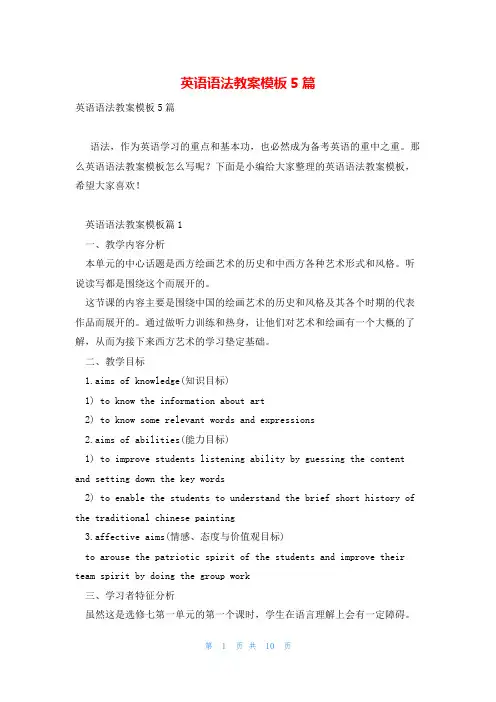
英语语法教案模板5篇英语语法教案模板5篇语法,作为英语学习的重点和基本功,也必然成为备考英语的重中之重。
那么英语语法教案模板怎么写呢?下面是小编给大家整理的英语语法教案模板,希望大家喜欢!英语语法教案模板篇1一、教学内容分析本单元的中心话题是西方绘画艺术的历史和中西方各种艺术形式和风格。
听说读写都是围绕这个而展开的。
这节课的内容主要是围绕中国的绘画艺术的历史和风格及其各个时期的代表作品而展开的。
通过做听力训练和热身,让他们对艺术和绘画有一个大概的了解,从而为接下来西方艺术的学习垫定基础。
二、教学目标1.aims of knowledge(知识目标)1) to know the information about art2) to know some relevant words and expressions2.aims of abilities(能力目标)1) to improve students listening ability by guessing the content and setting down the key words2) to enable the students to understand the brief short history of the traditional chinese painting3.affective aims(情感、态度与价值观目标)to arouse the patriotic spirit of the students and improve their team spirit by doing the group work三、学习者特征分析虽然这是选修七第一单元的第一个课时,学生在语言理解上会有一定障碍。
我们班学生男生为大多数,普遍听力较薄弱,也比较缺乏兴趣。
但是高二的学生通过一年多的高中英语学习,已经积累了一定的词汇,而且在听听力之前教师会让学生做热身,先熟悉目标词汇,使听力难度降低。
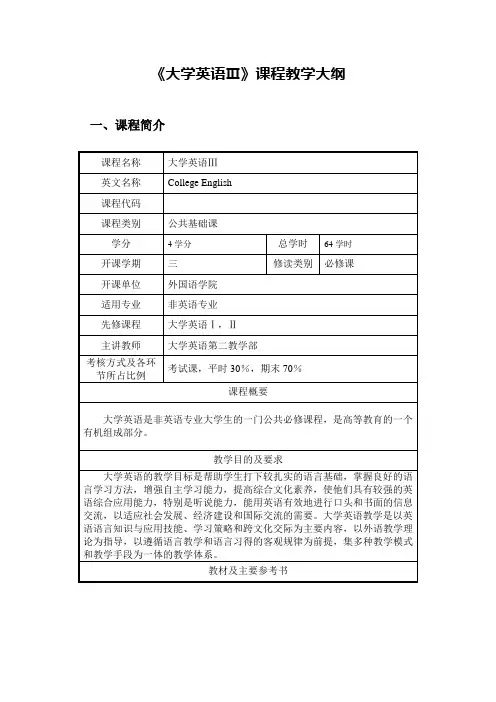
《大学英语Ⅲ》课程教学大纲一、课程简介[1] 李荫华主编(全新版)《大学英语》综合教程第3册上海外语教育出版社2002年7月第一版[2] 虞苏美主编(全新版)《大学英语》听说教程第3册上海外语教育出版社2002年7月第一版[3] 李荫华主编(全新版)《大学英语》快速阅读教程第3册上海外语教育出版社2002年9月第一版参考书:[1] 季佩英主编(全新版)《大学英语》综合教程教师用书第3册外语教学与研究出版社2002年7月第一版[2] 虞苏美主编(全新版)《大学英语》听说教程教师用书第3册上海外语教育出版社2002年7月第一版[3] 张成袆主编《大学英语语法手册》上海外语教育出版社2004年第一版二、课程章节主要内容及学时分配Unit One Changes in the Way We LiveText A Mr. Doherty Builds His Dream Life (5 periods)Main Idea: Tolerance for solitude and energy made it possible for the writer’s family to enjoy their pleasant but sometimes harsh country life. Students will beable to appreciate the various techniques employed by the writer(comparison and contrast, topic sentences followed by detail sentences,use of transitional devices, etc.)Process of Teaching:1.Warm-up: Talk about the topic why people change their places of living.2.Explanation of new words and phrases, language points3.Exercises4.Fast Reading—Four passages of Unit OneDiscussed Questions:1. Why do so many migrant workers move from the country to the city?2. Why do city people buy apartments or houses in the suburbs or even in the countryside?3. Why are tours of Zhou Zhuang, Li Jiang or any other old town so popular? Why are tourists willing to pay for a night in a farmer’s house instead of a hotel?Text B American Family Life: The Changing Picture (1 periods)Writing Strategy — Using comparison and contrast in essay writingComparing or contrasting enables us to understand each of the two things more clearly. So it seems natural to end a comparison and contrast paper with an insightful remark.Listening and Speaking CourseUnit One Parents (2 periods)1.Practice listening to a long dialogue about love between a son and hismother.2.Oral practicing: Pair work --- Have a conversation about the moralresponsibility of children to their parents, using the expressions provided.Unit Two Civil-Rights HeroesText A The Freedom Giver(5 periods )Main Idea: The author tells three stories about the Underground Railroad and the early Black civil rights movement. The three stories are chosen becausethey are representative of all participants in this movement. When welearn a foreign language, we must also learn the culture of the speakersof that language. Text A is a good case in point.Process of Teaching:1.Introducing cultural background knowledge.2.Explanation of new words and phrases, language points3.Exercises4.Fast Reading—Four passages of Unit TwoDiscussed Questions:1. What are the special contributions of Abraham, John and Martin to the Americannation?2. In what way did they die?Text B The Dream, the Stars and Dr. King(1 periods)Writing Strategy — Using library resourcesStudents will by now be used to using brainstorming to generate information on topics they write about. However, in writing about complex and serious issues, it is not expected to generate all the ideas by brainstorming. By brainstorming, they can develop a general framework. Yet, that is not sufficient to write a paper on a serious and complex topic. They will find it necessary to do some library research on the issue.Listening and Speaking CourseUnit Two Coincidence (2 periods)1. Listening to a long dialogue about a coincidence.2. Oral Practicing: Debating --- Arguments for or against believing in thesupernatural.Unit Three SecurityText A The Land of the Lock (5 periods)Main Idea: America is deteriorating into “the most insecure nation”. In addition to learning new vocabulary and the structure of the text (opening – body –conclusion), the students will learn to use comparison and contrast inwriting and to use keywords for efficient reading.Process of Teaching:1. Pre-reading tasksIn discussing the text, the teacher may lead off with something like the following: Once upon a time in China, on one picked up and pocketed anything left on the road, while no family had the need to bolt the doors at night. However, this is no longer true nowadays.2. Explanation of new words and phrases, language points.3. Exercises4. Fast Reading—Four passages of Unit ThreeDiscussed Questions:1. In our families, what do we do to try to prevent burglaries? For example, is there a burglary-proof door at your apartment?2. In our contact with the outside world, what precautions do we take to steer clear of danger? For example, do we speak to strangers?Text B Why I Bought a Gun (1 periods)Writing Strategy — Using cause and effect in essay writingThere are three basic ways of organizing cause-effect analysis: chronological organization; order of importance and categorical arrangement. For cause and effect analysis, some transitional words and phrases can be used.Listening and Speaking CourseUnit Three Marriage (2 periods)1.Listening to a long dialogue about a marriage agreement.2.Oral Practicing: Pair Work—Arguments for or against giving first priority toeconomic status in choosing a spouse.Unit Four ExtraterrestrialsText A The Water Place (5 periods)Main Idea: The narrator claims that no extraterrestrials will ever land on earth. By giving an account of his encounter with extraterrestrials, the narratormakes it clear why he claims that they will return no more. The studentswill understand the structure of the text (narration in time sequence) andappreciate the difference between formal speech and informal speech. Process of Teaching:1.Make presentation—“E.T. has been a topic of interest to experts and laymenalike ……”2.Explanation of new words and phrases, language points.3. Exercises4. Fast Reading—Four passages of Unit FourGroup Writing: My Encounter with an E.T.1)Students form groups to discuss where, when, and how they met the E.T., andwhat happened during the encounter. One student takes notes.2)Based on the notes, one student writes a story of about 100 words, and another isasked to draw a few pictures to illustrate the story.3)Other group members make suggestions for improvement.4)Each group sends a speaker to anther group, telling the latter their story with thehelp of the illustrations.Text B Is There Life on Planets Circling Other Stars(1 periods)Writing Strategy — How to write an expository essayIt is advisable to prepare enough material (details or examples) to help the explanation. Moreover, good exposition is often both instructive and interesting with many concrete examples.Listening and Speaking CourseUnit Four Stress (2 periods)1.Listening to two short conversations about stress.2.Introducing some expression about stress reducers.3.Oral Practicing: Pair Work--- ways to deal with stress.4.Model Test--- Listening (CET-4)Unit Five How to Celebrate HolidaysText A Writing Three Thank-You Letters(5 periods)Main Idea: On Thanksgiving Day 1943, as a young coastguardsman at sea, the writer came up with the idea of expressing his gratitude to people who hadhelped him before. The writer wrote three thank-you letters to his father,the Rev. Nelson and his grandmother and got three letters in reply. In theend the writer wishes everyone to find the good and praise it.Process of Teaching:1.Introducing cultural knowledge about Thanksgiving2.Explanation of new words and phrases, language points3.Exercises4.Fast Reading—Four passages of Unit FiveGroup Discussion:1. What should I thank my parents/teachers/friends for?2. Have I expressed my gratitude to the persons mentioned above?3. Are holidays a good time to express gratitude? Which holidays are the most appropriate?Text B Where Is Home?(1 periods)Writing Strategy — How to write thank-you lettersFeel free to respond to even the simplest favor, gift, or courtesy with a thank-you letter. Everyone appreciates receiving kind words in the mail.Listening and Speak CourseUnit Five Youth (2 periods)1.Listening to two stories about present-day youth.2.Oral Practicing: Pair Work--- reflections on volunteer activities.3.Watching a short play--- Growing Pains and repeat the lines sentence bysentence.Unit Six The Human TouchText A The Last Leaf(5 periods)Main Idea: The text tells a moving story about old Behrman who saved a young girl’s life at the expense of his own. The most touching thing about the story isthe way in which it captures the very best in humanity, the spirit ofkindness. The old artist appears to be a no-nonsense character, onewithout any time for sentimentality and softness. Yet we soon see hiskindly nature peeping through his rough manner. Only at the end of thestory, however, do we discover how kind and considerate he was, the oldman risking death to save a girl.Process of Teaching:1. Pre-reading tasksDebate: Charity begins at home2. Explanation of new words and phrases, language points3. Exercises4. Fast Reading—Four passages of Unit ThreeDiscussed Questions:1. Which among faith, hope and charity is the most important?2. Is love all we need to solve the world’s problems? Why or why not?Text B Thank You, Ma’m (1 periods)Writing Strategy – The general-to-specific patternEssays using the general-to-specific pattern move from a general statement about the subject to a detailed discussion that provides specific evidence, examples, and analysis to support or elaborate upon the general statement.Listening and Speaking CourseUnit Six The natural World (2 periods)1.Listening to two passages about how and why leaves of certain kinds of treeschange color in fall2.Oral Practicing: Pair Work--- the beauty of Nature3.Model Test--- Listening (CET-4)Unit Seven Making a LivingText A Life of a Salesman (5 periods)Main idea: Making a living as a door-to-door salesman demands a thick skin, both to protect against the weather and against constantly having the door shut inyour face. Bill Porter, the protagonist of the story, puts up with all this andnever gives in.Process of Teaching:1.Role play: Classroom salesman2.Explanation of new words and phrases, language points3.Exercises4.Fast Reading—Four passages of Unit SevenDiscussed Questions:1. How does the author succeed in combining in-depth reporting with skillful writing to produce an inspiring and enduring profile of the salesman Bill Porter?2. Would you rather have a low paid job that is interesting or a well-paid job that is boring?Text B Bricklayer’s Boy (1 periods)Writing Strategy – How to write a synopsisA synopsis is a summary of a longer piece of writing. A synopsis writer should keep in mind some requirements.Listening and Speaking CourseUnit Seven Courage (2 periods)1.Listening to a story about Krimali, a courageous girl.2.Oral practicing: Pair Work--- Bravery in the face of danger.3.Watching a short play—Growing Pains: Repeat the lines.Unit Eight CloningText A A Clone Is Born (5 periods)Main Idea: After Dolly, a clone sheep, was born, cloning could no longer be dismissed as science fiction. The ability to create an identical twin of a lamb is onlyone step short of cloning humans, which many find terrifying andoffensive. The technique of cloning is a two-edged sword.Process of Teaching:1.Making presentation –Give a brief history of the scientific research intocloning.2.Explanation of new words and phrases, language points3.Exercises4.Fast Reading— Four passages of Unit OneDiscussed Questions:1. What are the major pros and cons of human cloning?2. What is the greatest problem with human reproductive cloning?Text B Second Thoughts on Cloning (1 periods)Writing Strategy — How to write a persuasive essayThe effectiveness of an argument often depends on the background of the writer. To do this, you can quote experts and/or show that you have read widely about the subject by referring to information gathered from scientific literature.Listening and Speaking CourseUnit Eight Left-handedness (2 periods)1.Listening to two passages about left-handedness2.Model Test—Listening (CET-4)3.Oral practicing: Pair Work---Reflections on difficulties facing left-handedpeople三、课程教学的基本要求根据教育部2004年颁发的《大学英语课程教学要求》,大学英语教学从对能力的要求上分为一般要求、较高要求和更高要求。
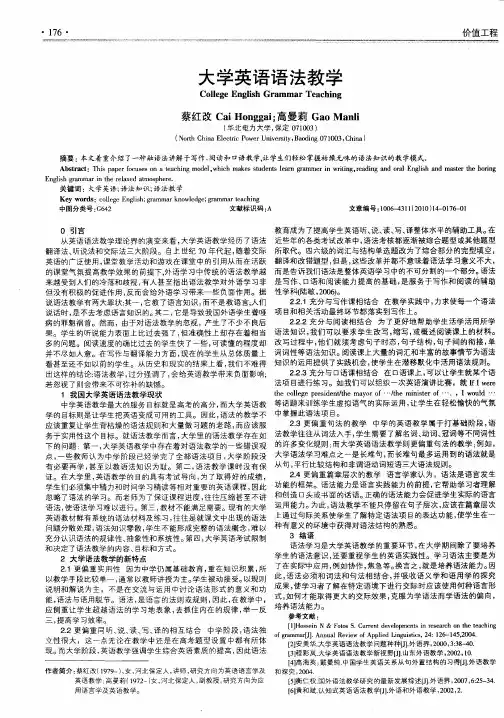

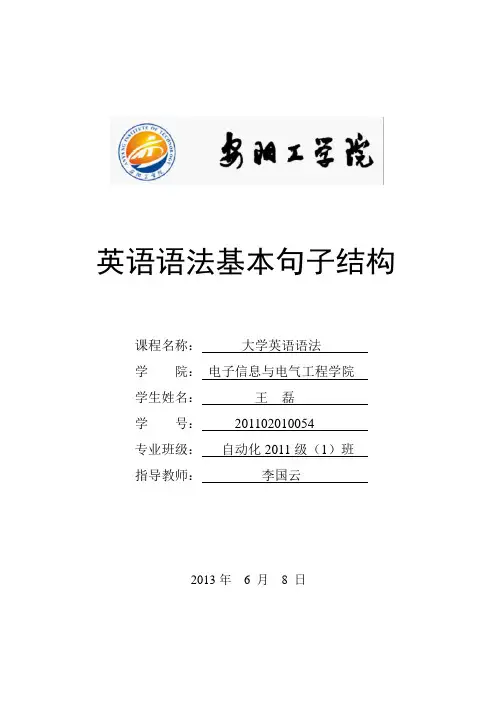
英语语法基本句子结构课程名称:大学英语语法学院:电子信息与电气工程学院学生姓名:王磊学号:201102010054专业班级:自动化2011级(1)班指导教师:李国云2013年 6 月8 日英语语法基本句子结构语法是对现成语言中规则的归纳和总结,以便学习者更快模仿掌握一门外语。
所以语法知识很重要,你不能用汉语的语法规则来造英语的句子,那样懂英语的人读不懂,同样不懂英语的语法规则也绝对读不懂英语短文。
不同词类的单词,按照一定的语法规则组合在一起,能够表达一个完整意思的语言单位叫句子,一个句子由各种功能不同的部分组成,这些部分叫做句子成分。
一个句子一般由两部分组成:主语部分和谓语部分。
根据各个句子成分在句子中所起得作用,可分为主语、谓语或谓语动词、宾语、表语、定语、补语、状语等。
主语全句述说的对象,常由名词、代词、名词性短语或分句充当,一般置于句首。
下面依次举例:Walls have ears.Football is my favorite.Three plus four equals seven.谓语或谓语动词说明主语的动作或状态,主要一般又实义动词或者系动词担任,助动词和情态动词加其他动词的适当形式充当,一般置于主语之后。
They should have finished their work.The chance may never come again.注意:英语中最基本的原则就是:一句话,只能有一个谓语动词宾语宾语表示动作的对象,是动作的承受者。
宾语一般放在及物动词之后。
英语介词后也会跟宾语。
可作宾语的有名词,代词,数词,动名词等,不定时式也可做及物动词的宾语。
下面依次举例:She refused to read that terrible book.We haven’t seen her for a long time.He needs a new dictionary.表语表述主语的身份、状态、特征,常由名词、代词、形容词、副词、数词、不定式、动名词、介词短语或分句充当。
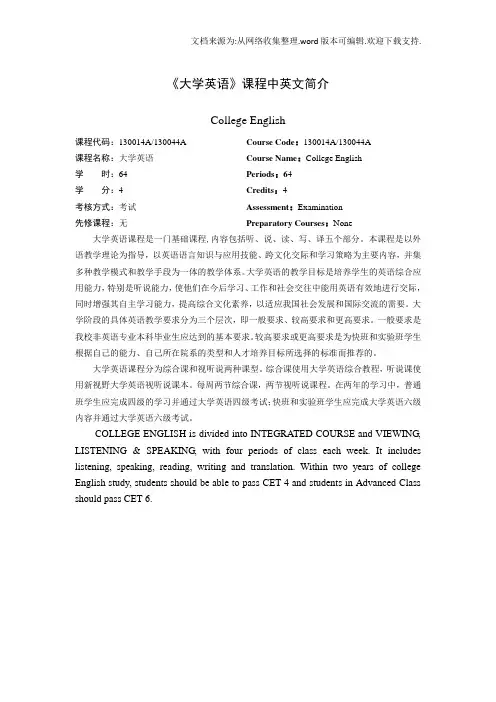
《大学英语》课程中英文简介College English课程代码:130014A/130044A Course Code:130014A/130044A课程名称:大学英语Course Name:College English学时:64 Periods:64学分:4 Credits:4考核方式:考试Assessment:Examination先修课程:无Preparatory Courses:None大学英语课程是一门基础课程,内容包括听、说、读、写、译五个部分。
本课程是以外语教学理论为指导,以英语语言知识与应用技能、跨文化交际和学习策略为主要内容,并集多种教学模式和教学手段为一体的教学体系。
大学英语的教学目标是培养学生的英语综合应用能力,特别是听说能力,使他们在今后学习、工作和社会交往中能用英语有效地进行交际,同时增强其自主学习能力,提高综合文化素养,以适应我国社会发展和国际交流的需要。
大学阶段的具体英语教学要求分为三个层次,即一般要求、较高要求和更高要求。
一般要求是我校非英语专业本科毕业生应达到的基本要求。
较高要求或更高要求是为快班和实验班学生根据自己的能力、自己所在院系的类型和人才培养目标所选择的标准而推荐的。
大学英语课程分为综合课和视听说两种课型。
综合课使用大学英语综合教程,听说课使用新视野大学英语视听说课本。
每周两节综合课,两节视听说课程。
在两年的学习中,普通班学生应完成四级的学习并通过大学英语四级考试;快班和实验班学生应完成大学英语六级内容并通过大学英语六级考试。
COLLEGE ENGLISH is divided into INTEGRATED COURSE and VIEWING, LISTENING & SPEAKING, with four periods of class each week. It includes listening, speaking, reading, writing and translation. Within two years of college English study, students should be able to pass CET 4 and students in Advanced Class should pass CET 6.《高级阅读Ⅰ》课程中英文简介Advanced Reading Ⅰ课程代码:130092A Course Code:130092A课程名称:高级阅读ⅠCourse Name:Advanced ReadingⅠ学时:32 Periods:32学分:2 Credits:2考核方式:考试Assessment:Examination先修课程:英语阅读Preparatory Courses:English Reading 《高级阅读Ⅰ》在进一步介绍阅读技巧和方法的基础上,重点分析这些技巧和方法如何应用到实际的阅读中,如何分析不同题材的特点,如何针对不同阅读目的运用不同的阅读方法,提高阅读的质量和数量,提高阅读理解能力。
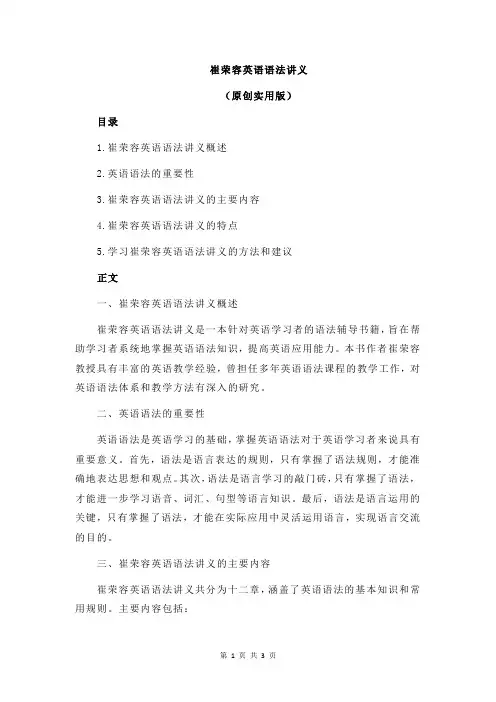
崔荣容英语语法讲义(原创实用版)目录1.崔荣容英语语法讲义概述2.英语语法的重要性3.崔荣容英语语法讲义的主要内容4.崔荣容英语语法讲义的特点5.学习崔荣容英语语法讲义的方法和建议正文一、崔荣容英语语法讲义概述崔荣容英语语法讲义是一本针对英语学习者的语法辅导书籍,旨在帮助学习者系统地掌握英语语法知识,提高英语应用能力。
本书作者崔荣容教授具有丰富的英语教学经验,曾担任多年英语语法课程的教学工作,对英语语法体系和教学方法有深入的研究。
二、英语语法的重要性英语语法是英语学习的基础,掌握英语语法对于英语学习者来说具有重要意义。
首先,语法是语言表达的规则,只有掌握了语法规则,才能准确地表达思想和观点。
其次,语法是语言学习的敲门砖,只有掌握了语法,才能进一步学习语音、词汇、句型等语言知识。
最后,语法是语言运用的关键,只有掌握了语法,才能在实际应用中灵活运用语言,实现语言交流的目的。
三、崔荣容英语语法讲义的主要内容崔荣容英语语法讲义共分为十二章,涵盖了英语语法的基本知识和常用规则。
主要内容包括:1.名词和冠词:介绍名词的分类、冠词的用法以及它们在句子中的作用。
2.代词:讲解人称代词、物主代词、指示代词等各类代词的用法。
3.形容词和副词:分析形容词和副词的性质、功能以及它们在句子中的位置。
4.动词:讲述动词的分类、时态、语态以及情态动词的用法。
5.介词:介绍介词的分类、功能及其在句子中的作用。
6.连词:讲解并列连词、从属连词的用法以及它们在句子中的作用。
7.句子结构:分析句子成分、句子类型以及句子结构的规律。
8.句子成分:讲解主语、谓语、宾语等句子成分的功能和特点。
9.句子类型:介绍陈述句、疑问句、祈使句、感叹句等句子类型的特点和用法。
10.句子的语序:分析句子的语序规律及其在实际应用中的作用。
11.句子的修辞:介绍句子的修辞手法,如比喻、拟人等,以及它们的表达效果。
12.句子的翻译:讲解句子翻译的方法和技巧,以及如何将中文翻译成英文或英文翻译成中文。